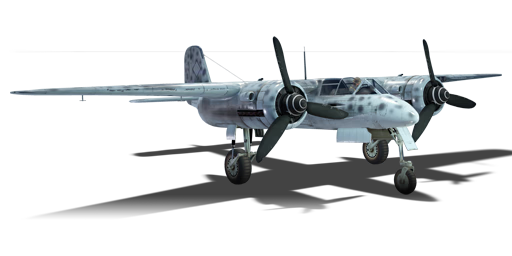



The Ta 154 A-1 Moskito was a German twin-engined interceptor and night fighter built in small numbers for the Luftwaffe. The plane received its nickname from the British de Havilland Mosquito fighter-bomber, as it was supposed to be fast and made mainly from wood just like its British counterpart. The development of the Moskito started on personal request of Generalfeldmarschall Erhard Milch, the State Secretary of the RLM. This caused a dispute between Milch and the RLM and Ernst Heinkel, who both favoured his He 219 Uhu for acceptance into service. On July 1st 1943, the first prototype achieved a speed of 700 km/h, although with no armament and radar installed, surpassing the Ju 388 and He 219 it was tested alongside. The third prototype was the first to carry armament, and the weight of the guns and drag from its radar made it slower by 75 km/h than the first prototype, but still faster than the He 219. A series of 15 planes similar to the V3 prototype was made and accepted into service as Ta 154 A-0. By June 1944, a series of 154 Ta 154 A-1 equipped with Jumo 213 engines instead of the Jumo 211R was manufactured. However, prior to delivery, the factory producing glue for the airframes was bombed by the RAF and different glue had to be sourced. The replacement glue was found to react corrosively to the airframe and caused several catastrophic accidents of the Ta 154 and caused delays in the He 162 program as well. The Ta 154 project was cancelled by the RLM in September 1944 with about 50 completed aircraft, with an unknown number serving with Nachtjageschwader 3 and a few used for pilot training.
The Ta-154 A-1 was introduced in Update 1.65 "Way of the Samurai" as a part of the revenue share program and was created by Vitaly "NovA29R" Vostokov (model) and Michael "__StrafeMike__" Ioannidis (texture). The Ta 154 A-1 has very powerful frontal armament, placed in the fuselage, which can give you quick and easy kills. Unfortunately, it doesn't turn very well at low speeds so it is recommended to keep your speed up and Boom & Zoom. Turning should be a last resort. If you try to get an edge in a turn-fight using your flaps, you should watch your speed as your flaps can break off very easily at speeds above 450 km/h (279 mph). The roll-rate of the Ta 154 is almost as good as the Fw 190's roll-rate, this is due to the fact that there are no fuel tanks in the wings. This advantage can and should most definitely be used when flying evasively but when at low altitude, do periodically check what's in front of you.
flaps
flaps
flaps
brake
| Belt | Belt filling | Armor penetration (mm) at a distance: | |||||
|---|---|---|---|---|---|---|---|
| 10 m | 100 m | 500 m | 1000 m | 1500 m | 2000 m | ||
| HEI-T/I | 6 | 6 | 6 | 6 | 6 | 6 | |
| HEI-T/HEI-T/HEI-T/HEF-I | 4 | 4 | 4 | 4 | 4 | 4 | |
| HEI-T/HEI-T/HEI-T | 4 | 4 | 4 | 4 | 4 | 4 | |
| HEI | 4 | 4 | 4 | 4 | 4 | 4 | |
| Belt | Belt filling | Armor penetration (mm) at a distance: | |||||
|---|---|---|---|---|---|---|---|
| 10 m | 100 m | 500 m | 1000 m | 1500 m | 2000 m | ||
| IT/IT/APHE/HEI | 21 | 19 | 8 | 3 | 1 | 1 | |
| IT/HEI/HEI/AP-I | 27 | 24 | 14 | 7 | 3 | 2 | |
| AP-I/HEI/HEI/HEI/HEI/IT | 27 | 24 | 14 | 7 | 3 | 2 | |
| APHE/APHE/APHE/IT | 21 | 19 | 8 | 3 | 1 | 1 | |
| FI-T/FI-T/FI-T/IT/IT | 21 | 19 | 8 | 3 | 1 | 1 | |
| HEI/HEI/HEI/APHE/AP-I | 27 | 24 | 14 | 7 | 3 | 2 | |







 2 x (60 / 190 / 310) %
2 x (60 / 190 / 310) % 
 2 x 142 %
2 x 142 % 

Flight performance | |
|---|---|
Survivability |
|---|
Weaponry |
|---|